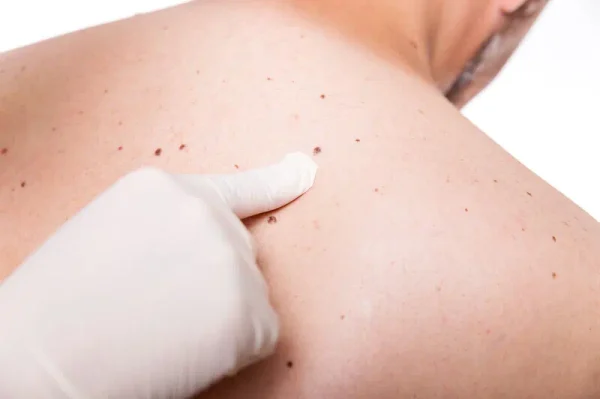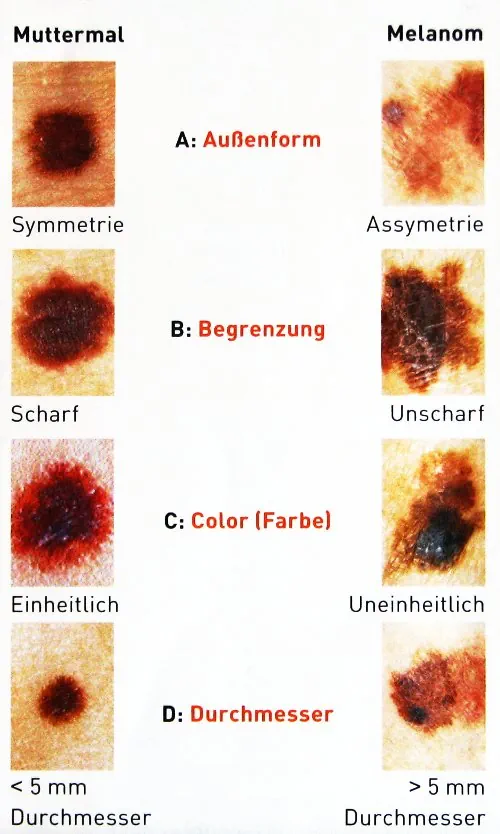Birthmark removal Vienna
Not every growth of pigment-forming skin cells is a harmless birthmark. Regularly check your skin and moles for changes and go for regular mole checks.
In our practices in Tulln and in Vienna you can have your moles examined and removed.

Table of contents
Birthmark removal overview
Birthmark removal methods
Surgical excision: The birthmark is removed with a scalpel, often together with a small margin of healthy skin.
Procedure:
- Preparation: Local anaesthesia is used to numb the area.
Removal: The birthmark is cut out and the wound is closed with stitches. - Aftercare: Sutures are removed after approx. 7-14 days.
- Advantages: Precise histological examination possible, high degree of certainty in the case of suspected skin cancer.
- Side effects: Scarring, risk of infection.
Shave excision (scraping): The birthmark is removed superficially with a blade.
Procedure:
- Preparation: Local anaesthesia is used.
Removal: The birthmark is removed flat to the skin surface. - Aftercare: The wound usually heals without stitches, plasters or dressings may be required.
- Advantages: Quick and simple method, minimally invasive.
- Side effects: Shallow scarring possible, not suitable for deeper moles.
Birthmark removal by laser: The laser vaporises the birthmark using high-energy light.
Procedure:
- Preparation: Local anaesthesia can be used, especially for larger moles.
- Treatment: The laser is directed at the birthmark to remove it.
- Aftercare: Wound usually heals without stitches, slight reddening or scab formation possible.
- Advantages: No incisions, minimally invasive, little bleeding.
Side effects: Scarring possible, no histological examination of the entire mole possible.
Treatment duration
Depending on the removal method, from 30 minutes.
Side effects
Possible side effects, depending on the removal method:
Blistering, pigment changes, scarring, (low) risk of infection
Results
HealingWounds usually heal within 1-2 weeks, depending on the method and localisation.
ScarringThe risk and extent of scarring vary depending on the method and individual healing tendency. Scars can later be minimised using laser therapy.
Aftercare
Wound careRegular cleaning and, if necessary, application of antiseptic ointments.
Sun protectionProtect the affected area from UV radiation to prevent pigmentation changes.
Control examinationsEspecially when removing for medical reasons to ensure that no malignant cells are present.
Costs of a mole removal
As a rule, costs for medical indications are covered by health insurance. For cosmetic indications, the patient usually has to pay themselves.
Treatment: from 300,- €*
*Guide prices: The cost of treatment depends on the method and the size and number of moles.
What is a birthmark?
The term mole (nevus) refers to all types of benign skin growths. A birthmark can be brown in colour (hence known as a mole) or consist of red cells from blood vessels or yellow sebaceous gland cells. Moles are usually harmless, but can develop into a skin cancer. Checking moles is recommended once a year. An early diagnosis and subsequent therapy significantly increases your chance of a complete cure.
Birthmark removal Vienna
In our dermatological practice in 1180 ViennaIn our clinic, both the necessary preventive examinations (skin cancer screening) and the desired removal of moles for medical or aesthetic reasons can be carried out professionally and using the latest techniques. If a mole cannot be clearly identified as benign, it should be removed and histologically examined as a precaution.
The choice of method to remove a mole will be made at the initial appointment to determine the best option based on the type of mole and individual needs.
Regular birthmark check as skin cancer prevention:
Skin cancer has become one of the most common cancers in recent years.
With a regular birthmark check this risk can be significantly reduced. The screening is carried out painlessly using digital reflected light microscopy. The reflected light microscope is a special magnifying glass with light that uses tenfold magnification to look into deeper layers of the skin and recognise altered structures of moles. If the diagnosis is uncertain, small tissue samples can be taken or the moles can be removed immediately.
What features should you look for in a nevus?
The following points speak for an early presentation to the dermatologist:
- The birthmark (mole) is asymmetrical (usually round or oval).
- Its normally smooth, sharp edges are frayed or unclearly defined.
- It has changed its previous colour or has inconsistent colours.
- The nevus is getting bigger.
- It changes its characteristics (itches, oozes, bleeds or rises).
Skin cancer screening
A regular, e.g. yearly check of the birthmarks is always sensible! No matter what age you are, not every birthmark is harmless. Protect yourself with regular skin cancer screening at the dermatologist.
Birthmark - Melanoma Comparison Table
The criteria shown in the figure help to systematically distinguish the appearance and changes of moles from melanoma (skin cancer).

Frequently asked questions about birthmark control and removal
What exactly are moles?
These are pigment-forming cells that rise from deep layers to the surface of the skin and multiply there. In most cases they are harmless, but in the worst case they can degenerate and become skin cancer.
How often should moles be examined?
People with inconspicuous moles that do not change are recommended to have a check-up every five years. If you have many nevi or are a risk patient, a preventive check-up once a year is recommended.
What are the methods of birthmark removal?
Ablation of the moles with the laser:
The removal of nevi by means of the high-frequency laser is a very gentle form of treatment. This method is suitable for removal for aesthetic reasons and for smaller moles. The treatment under local anaesthesia takes only a few minutes and produces visually beautiful results.
Electrosurgical removal:
Cauterisation (high frequency electrosurgery) is a procedure used for benign, protruding growths. A very fine wire loop is inserted and the tissue is gently destroyed with the cautery.
Photodynamic therapy:
A non-invasive form of treatment for superficial keratoses that relies on visible light to create aggressive oxygen molecules and free radicals that destroy the tissue of the mole but leave normal tissue intact.
Surgical removal:
If there is an urgent suspicion of skin cancer (basalioma, melanoma), removal with a scalpel is the method of choice. The affected skin area is minimally invasively excised under local anaesthesia and histologically examined. If the tissue examination shows the diagnosis of skin cancer, another operation must be performed at a distance of one centimetre to make sure that there is no more degenerated tissue in the skin area.
Can a mole removal leave scars?
Many patients, especially those who have moles removed from the face, worry that visible scars will remain. Experienced dermatologists, such as Dr Orasche, use special state-of-the-art techniques and achieve aesthetically pleasing results with their treatments.
Can you remove moles yourself?
You should never remove moles yourself. This can lead to life-threatening infection and unsightly scars.
What are the different types of skin cancer?
White skin cancer (basalioma): usually does not form metastases.
Actinic keratosis: Preliminary stage of white skin cancer. These are reddish-brown patches that are rough to the touch and mainly appear with age in areas that are often exposed to the sun.
Black skin cancer (malignant melanoma): already forms metastases in the early phase.
Who is particularly at risk of developing skin cancer?
Genetic load:
If there are cases of skin cancer in the family, regular preventive skin cancer screening is recommended.
Light skin type:
People with fair skin, blue or green eyes, blond or reddish hair are particularly at risk and get sunburnt quickly.
Increased moles:
People whose skin has more than 50 moles also belong to the group of people who should have their skin checked regularly.
Sun and UVA rays - main triggers for skin cancer:
Anyone who had frequent sunburns as a child or who is exposed to strong sunlight for long periods of time without adequate sun protection has an increased risk of developing skin cancer.
Congenital birthmarks:
Moles that have been present since birth or develop during the first year of life should be observed.
Patient testimonials
I came to Dr. Orasche through a recommendation and am thrilled with her medical approach, which gets to the essentials without much fuss. The results are obvious to me and the appointments with Dr. Orasche are a welcome time-out with visible effect.

